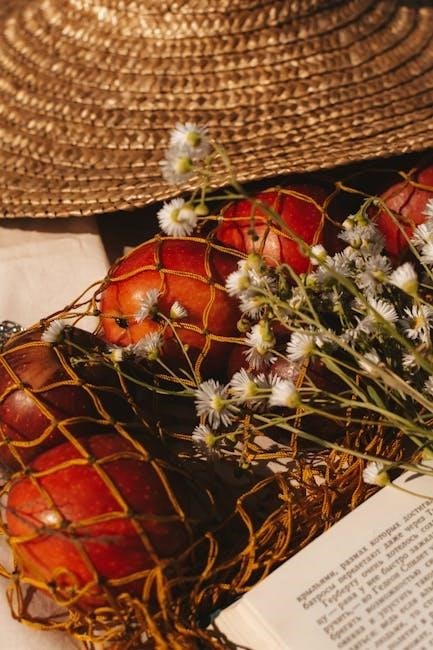The Fowlers Vacola Preserving Book is a comprehensive guide to traditional food preservation methods. It details the vacuum-sealing process‚ enabling efficient‚ cost-effective‚ and sustainable home preservation.
Overview of the Fowlers Vacola Method
The Fowlers Vacola method is a traditional food preservation technique using glass jars‚ rubber rings‚ and metal lids. It involves heating jars to create a vacuum seal‚ preventing spoilage by removing oxygen. Ideal for high-acid foods like fruits and pickles‚ this method relies on natural acidity and heat to ensure safety. The process is cost-effective‚ reduces waste‚ and allows year-round enjoyment of seasonal produce. Originating in Australia in 1915‚ it remains popular for its simplicity and effectiveness in home preservation‚ with detailed guidance provided in the Fowlers Vacola Preserving Book.
Historical Background of Fowlers Vacola
Fowlers Vacola was founded in Australia by Joseph Fowler in 1915‚ originating from a concept developed in the UK by George Fowler. The method gained popularity during the Great Depression for its cost-effectiveness. In 1934‚ the company became public‚ with the iconic “Mrs. B Thrifty” character promoting its kits. Known for high-quality‚ additive-free preservation‚ Fowlers Vacola remains a trusted name‚ still family-owned and committed to sharing preserving knowledge since its inception.
Importance of Preserving Food at Home
Preserving food at home is a practical way to reduce waste‚ save money‚ and enjoy seasonal produce year-round. It allows families to capture the freshness and nutrition of fruits and vegetables at their peak‚ while avoiding additives found in commercial products. By preserving food‚ households can enhance meal preparation with homemade ingredients like sauces‚ relishes‚ and pickles. The Fowlers Vacola method is particularly valued for its simplicity and effectiveness in creating high-quality‚ long-lasting preserves‚ making it a sustainable and rewarding practice for home cooks and gardeners alike.

The Fowlers Vacola Preserving System
The Fowlers Vacola Preserving System uses glass jars‚ rubber rings‚ and metal clips to create a vacuum seal‚ preserving food by removing air and preventing spoilage.
Key Components of the System
The Fowlers Vacola system includes durable glass jars‚ single-use rubber rings‚ and pressed metal lids. The jars are paired with metal tension clips that secure lids during processing. A preserving unit‚ available in electric or stovetop models‚ heats jars to eliminate air and create a vacuum seal. Accessories like bottle openers and storage lids enhance functionality. The system relies on high-acid foods to ensure safety and longevity. These components work together to preserve food naturally‚ without additives‚ making it a reliable method for home use. Proper maintenance of equipment ensures optimal performance and longevity of preserved goods.
How the Vacuum Seal Works
The vacuum seal is created by heating filled jars in a Fowlers Vacola preserving unit. As the jars are heated‚ air escapes‚ and a vacuum forms upon cooling. The rubber ring ensures an airtight seal‚ preventing contamination. This process pasteurizes the food and destroys spoilage microbes‚ making it safe for long-term storage. The vacuum seal is maintained by the metal lid and clip during heating‚ then naturally Tightens as the jar cools‚ ensuring a secure and sterile environment for preserved foods. This method effectively locks in freshness and flavor without additives.
Comparison with Other Preserving Methods
Fowlers Vacola stands out as a unique preserving method using vacuum-sealed glass jars. Unlike pressure canning‚ it relies on heat and natural acidity to create a sterile environment; Freezing and dehydrating require specific equipment and alter food texture‚ while Fowlers Vacola preserves food in its natural state. The vacuum seal prevents contamination without additives‚ making it ideal for high-acid foods. This low-tech‚ cost-effective approach is perfect for home use‚ ensuring long-term storage without compromising flavor. It’s a sustainable alternative to modern methods‚ maintaining nutritional value and freshness effectively.
Equipment and Supplies
Fowlers Vacola preserving requires glass jars‚ single-use rubber rings‚ metal lids‚ and clips. Electric or stovetop preserving units are used for heat processing‚ ensuring a vacuum seal for long-term storage.
Fowlers Vacola Jars and Lids
Fowlers Vacola jars are heat-resistant glass containers designed for food preservation. They are paired with single-use rubber rings and pressed metal lids‚ which create a vacuum seal during cooling. Unlike traditional Mason jars‚ Fowlers Vacola jars and lids are not threaded‚ relying instead on clips to secure the lid during processing. The rubber rings are essential for achieving a tight seal‚ while the lids and clips ensure proper closure. Jars and lids can be reused if in good condition‚ but rubber rings should be replaced each time to guarantee a reliable vacuum seal. Regular inspection for damage or wear is crucial for safe preservation.
Rubber Rings and Clips
Rubber Rings and Clips
Rubber rings and clips are essential components in the Fowlers Vacola preserving system. The rubber rings‚ which come in various sizes‚ ensure a tight seal between the jar and lid during processing. Clips hold the lids securely in place while heating‚ allowing air to escape and creating a vacuum as the jars cool. Rubber rings are recommended for single use to guarantee a reliable seal‚ while clips can be reused if undamaged. Proper sizing is crucial‚ as mismatched rings and jars can lead to seal failure. Regular inspection of these accessories ensures effective preservation and prevents contamination. Accessories are widely available online and in preserving stores.

Preserving Units (Electric and Stovetop)
Fowlers Vacola offers two types of preserving units: electric and stovetop. The electric units‚ such as the Simple Natural Preserving and Professional Preserving models‚ heat jars evenly and efficiently. They process jars in 60-90 minutes‚ creating a vacuum seal. The stovetop model provides a traditional option for those without electric units. Both units ensure food is heated to pasteurize contents‚ eliminate air‚ and form a vacuum seal. They are designed for high-acid foods‚ making them ideal for preserving fruits‚ pickles‚ and sauces. Proper usage‚ as outlined in the instruction booklet‚ is essential for safe and effective preservation. Regular maintenance ensures longevity and reliability.

Step-by-Step Preserving Process
Prepare food‚ fill clean jars‚ secure lids with rubber rings and clips. Submerge jars in the preserving unit‚ heat for 60-90 minutes‚ then let cool to form a vacuum seal.
Preparing Food for Preserving
Preparing food for preserving involves washing‚ peeling‚ and chopping fruits or vegetables. High-acid foods like fruits and pickles are ideal for the Fowlers Vacola method. Ensure produce is fresh and seasonal for optimal flavor. Pack food tightly into clean jars‚ leaving space as instructed. Add liquids like syrup or brine if required. Avoid overfilling to prevent contamination. The Fowlers Vacola system relies on natural acidity and heat to create a sterile environment‚ eliminating the need for additives. Always follow the guide for specific preparation steps to ensure safety and success in preserving.

Filling and Sealing Jars
Filling jars requires careful preparation to ensure proper sealing. Clean‚ hot jars are filled with prepared food‚ leaving the recommended headspace. A rubber ring is placed on the jar mouth‚ followed by the lid and spring clip to secure it. The clip holds the lid in place during heating‚ allowing air to escape. After processing in the preserver‚ the jar cools‚ creating a vacuum seal. Check jars for cracks or chips and ensure rubber rings are in good condition for a tight seal. Proper sealing prevents contamination and spoilage‚ ensuring food remains fresh for long-term storage.
Heating and Cooling Process
The heating process involves submerging filled jars in water within the Fowlers Vacola preserving unit. The unit heats the jars for 60-90 minutes‚ pasteurizing the contents and removing air. After heating‚ jars are left to cool‚ allowing the vacuum seal to form naturally. This step is crucial for creating an airtight environment that prevents contamination. The cooling phase ensures the lid seals tightly‚ maintaining freshness and safety. Proper heating and cooling are essential for achieving long-term preservation and preventing spoilage‚ making this step a cornerstone of the Fowlers Vacola method.

Benefits of Using Fowlers Vacola
Fowlers Vacola offers cost-effective preservation‚ reduces food waste‚ and enables long-term storage of seasonal produce. It ensures freshness and nutrition while minimizing additives‚ perfect for home use.
Cost-Effectiveness
Fowlers Vacola preserving is a budget-friendly method for home food preservation. The initial investment in equipment pays off over time‚ as reusable jars and accessories reduce long-term costs. By preserving seasonal produce‚ families can save money on out-of-season foods and enjoy their favorites year-round. The system is especially economical for households aiming to reduce food waste and reliance on processed goods. With proper care‚ Fowlers Vacola equipment lasts for decades‚ making it a cost-effective choice for sustainable living and home food storage.
Reducing Food Waste
Fowlers Vacola preserving helps minimize food waste by allowing households to store surplus produce efficiently. Seasonal fruits and vegetables‚ often abundant and perishable‚ can be preserved using the vacuum-sealing method. This ensures that no harvest goes to waste‚ extending the shelf life of fresh goods. By bottling excess produce‚ families can enjoy their homegrown or locally sourced ingredients throughout the year. This sustainable practice aligns with eco-friendly living‚ promoting resourcefulness and reducing the need for disposable packaging. Preserving food also means fewer trips to the market‚ further cutting down on waste and supporting a more self-sufficient lifestyle.
Long-Term Food Storage
Fowlers Vacola preserving enables long-term food storage by creating airtight‚ vacuum-sealed jars that prevent spoilage and contamination. Properly sealed jars can be stored for many years without refrigeration‚ maintaining the freshness and nutritional value of preserved foods. This method is especially useful for seasonal produce‚ allowing families to enjoy their favorite fruits and vegetables year-round. The vacuum seal ensures that no air can enter the jar‚ inhibiting the growth of bacteria and mold. With correct storage in a cool‚ dark place‚ Fowlers Vacola preserved foods remain safe and flavorful‚ making it an ideal solution for long-term food storage and sustainability.

Challenges and Considerations

The Fowlers Vacola method requires space for equipment and stored jars‚ significant time for preparation and processing‚ and is limited to high-acid foods for safety reasons.
Space and Storage Requirements
Successful use of the Fowlers Vacola system demands adequate storage space for both the equipment and the preserved jars. A cool‚ dark‚ and dry area with consistent temperatures between 12-15°C is ideal for storing preserves. The pantry or cupboard should be away from heat sources like ovens or radiators to maintain stable conditions. Additionally‚ the preserving unit itself requires a dedicated area during processing‚ highlighting the need for a spacious kitchen setup. Proper organization ensures longevity and safety of preserved foods‚ making storage planning essential for optimal results.
Time Investment
The Fowlers Vacola method requires a significant time investment‚ including food preparation‚ jar filling‚ and the heating process‚ which can take 60-90 minutes. Monitoring the unit and ensuring proper cooling adds to the duration. While the process is straightforward‚ it demands patience and consistency. Regular maintenance and cleanup of equipment also consume time. However‚ the effort pays off with long-term food storage and reduced waste‚ making it a rewarding skill for home preservers. Proper time management is key to mastering this traditional preserving technique effectively.
Limited to High-Acid Foods
The Fowlers Vacola method is primarily suitable for preserving high-acid foods‚ such as fruits‚ pickles‚ and tomato-based products. This limitation arises because the process relies on natural acidity to inhibit bacterial growth. Foods with low acidity require pressure canning to ensure safety‚ as they pose a higher risk of spoilage and contamination. The method is ideal for high-acid items‚ ensuring a safe and effective preservation process. Always adhere to tested recipes and guidelines to maintain food safety and quality when using the Fowlers Vacola system. This ensures optimal results and prevents potential health risks associated with improper preservation techniques.
Food Safety and Best Practices
Always follow tested recipes and guidelines to ensure safe preservation. Check seals before storage and maintain a clean environment to prevent contamination. Proper practices guarantee quality results.
Understanding pH Levels and Acidity
Acidity plays a crucial role in food preservation. High-acid foods‚ with a pH below 4.6‚ naturally inhibit bacterial growth. The Fowlers Vacola method relies on this acidity to ensure safety. Proper testing ensures that foods are within a safe pH range‚ preventing spoilage and contamination. Always use tested recipes to maintain acidity levels‚ especially for fruits and pickled vegetables. Correct pH balance ensures a vacuum seal and long-term storage safety. Monitoring acidity helps preserve food naturally without additives‚ aligning with the method’s principles. This step is vital for both safety and flavor retention in preserved foods.
Signs of Spoilage
Identifying spoilage is critical for food safety. Look for visible mold‚ yeast growth‚ or cloudiness in the liquid. Bubbling‚ sliminess‚ or an off smell indicates contamination. If the lid is unsealed‚ lifted‚ or shows pressure‚ the contents may be unsafe. Leaks‚ fermentation‚ or bad odors are red flags. Never taste unsealed preserves‚ as harmful bacteria may not always show obvious signs. Dispose of spoiled food carefully and clean the jar thoroughly. Always check for these signs before consuming. Regular inspections and proper storage can prevent spoilage‚ ensuring your preserves remain safe and fresh for years when stored correctly using the Fowlers Vacola method.
Proper Storage Conditions
Proper storage ensures the longevity and safety of preserved foods. Store jars in a cool‚ dark place with consistent temperatures between 12°C and 15°C. Avoid areas near ovens‚ stovetops‚ or dryers. Remove clips after sealing and label jars with dates. Keep them upright to prevent residue from sticking to lids. Check seals periodically and discard any jars showing signs of spoilage. A dry‚ stable environment prevents moisture buildup‚ which can lead to mold or rust. Properly stored preserves retain quality and nutrition for up to a year. Always follow these guidelines to maintain the integrity of your Fowlers Vacola preserves and ensure they remain safe to eat.
Tips for Successful Preserving
Ensure equipment is in good condition‚ use new rubber rings‚ and follow Fowlers Vacola instructions carefully. Label and date jars for easy identification and storage. This ensures safety and organization.
Checking Equipment Condition
Before starting‚ inspect Fowlers Vacola jars‚ lids‚ and rubber rings for damage. Ensure jars are free from chips or cracks‚ especially around the rim. Check lids for dents or rust. Rubber rings should be replaced annually to maintain a proper seal. Examine the preserving unit for any wear or damage. Regular maintenance ensures longevity and safety. Proper inspection guarantees a successful preserving process and prevents potential failures during storage.
Using the Right Accessories
Using the correct accessories is crucial for successful preserving with Fowlers Vacola. Ensure jars‚ lids‚ and rubber rings match in size and type. Replace rubber rings annually for optimal sealing. Use Fowlers Vacola-specific tools‚ like bottle openers‚ to safely remove lids without damaging them. Always check compatibility to maintain vacuum integrity. Proper accessories prevent seal failures and ensure food safety. Using the right tools and parts guarantees a reliable preserving process and extends the life of your equipment.
Labeling and Dating Jars
Labeling and dating jars is essential for maintaining organization and ensuring food safety. Clearly mark each jar with its contents‚ date‚ and any relevant storage instructions. Use durable labels or markers to prevent fading. Proper labeling helps identify older preserves‚ ensuring you use them before they lose quality. Dating jars also aids in monitoring storage conditions and maintaining a “first in‚ first out” system. This practice prevents forgotten preserves and reduces waste‚ making your preserving efforts more efficient and enjoyable. Consistent labeling enhances the overall preservation experience and ensures clarity when selecting jars for use.

Troubleshooting Common Issues
Failed seals‚ mold growth‚ and equipment malfunctions are common issues. Regularly inspect jars‚ lids‚ and rubber rings for damage. Addressing these promptly ensures safe and successful preserving outcomes.
Failed Seals and Leaks
Failed seals and leaks are common issues in Fowlers Vacola preserving. They often occur due to worn or damaged rubber rings‚ improper lid alignment‚ or insufficient heating. Always inspect rubber rings for cracks or deterioration before use. Ensure lids are securely clipped and jars are heated evenly. If a seal fails‚ the jar may leak or allow air to enter‚ leading to spoilage. Replace faulty rubber rings and reprocess jars if necessary. Regularly check seals after cooling to ensure vacuum retention. Proper maintenance and inspection can prevent most sealing issues‚ ensuring long-term preservation success and food safety.
Dealing with Mold or Yeast Growth
Mold or yeast growth in preserved foods is a serious issue‚ indicating contamination. It often occurs due to improper sealing‚ insufficient heating‚ or low acidity. Always discard jars with visible mold or yeast‚ as they can produce harmful toxins. Prevent growth by ensuring high-acid ingredients‚ proper sterilization‚ and maintaining vacuum seals. Regularly inspect stored jars for signs of spoilage‚ such as bubbling‚ cloudiness‚ or unpleasant odors. If mold is detected‚ do not taste the contents—dispose of them immediately. Follow Fowlers Vacola guidelines strictly to minimize contamination risks and ensure safe‚ long-term preservation.
Equipment Maintenance

Regular maintenance of Fowlers Vacola equipment is essential for optimal performance and food safety. Wash all components‚ including jars‚ lids‚ and rubber rings‚ in hot soapy water after use. Dry thoroughly and store in a clean‚ dry place. Inspect jars for chips or cracks‚ and replace worn or damaged rubber rings. Preserve the condition of metal clips and lids by avoiding abrasive cleaners. Before each use‚ ensure all parts are in good working order to maintain vacuum seals and prevent contamination. Proper care extends the lifespan of your equipment and ensures reliable food preservation results every time;
The Fowlers Vacola Preserving Book offers a detailed guide to sustainable food preservation‚ ensuring seasonal flavors are enjoyed year-round through its proven‚ chemical-free vacuum-sealing method.
The Fowlers Vacola Preserving Book provides a detailed guide to home food preservation using the vacuum-sealing method. It emphasizes the use of glass jars‚ rubber rings‚ and metal lids to create airtight seals‚ ensuring food stays fresh without additives. The method is cost-effective‚ reduces waste‚ and allows for long-term storage of seasonal produce. Ideal for high-acid foods‚ it relies on heat and natural acidity to eliminate spoilage. With step-by-step instructions‚ it covers preparation‚ processing‚ and storage. Proper storage in a cool‚ dark place is essential for maintaining seals and safety. This method is a sustainable way to enjoy nutritious‚ homemade preserves year-round.
Encouragement to Start Preserving
Preserving food with the Fowlers Vacola method is a rewarding and sustainable way to enjoy seasonal produce year-round. It’s easy to learn‚ cost-effective‚ and helps reduce waste while providing healthy‚ additive-free meals. Perfect for beginners‚ the Fowlers Vacola system offers clear guidance and durable equipment. Start small with simple recipes‚ and soon you’ll enjoy the satisfaction of preserving your favorite foods. With the Fowlers Vacola Preserving Book as your guide‚ you’ll confidently create delicious‚ long-lasting preserves. Take the first step toward self-sufficiency and healthier eating—your pantry and family will thank you!